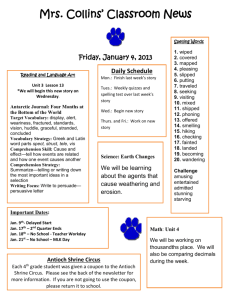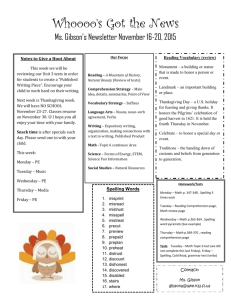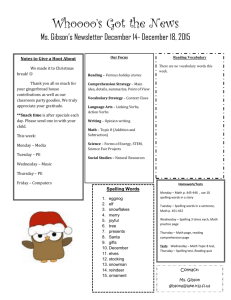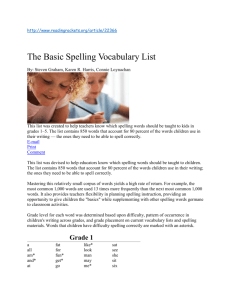File - Ashley Valentino
advertisement
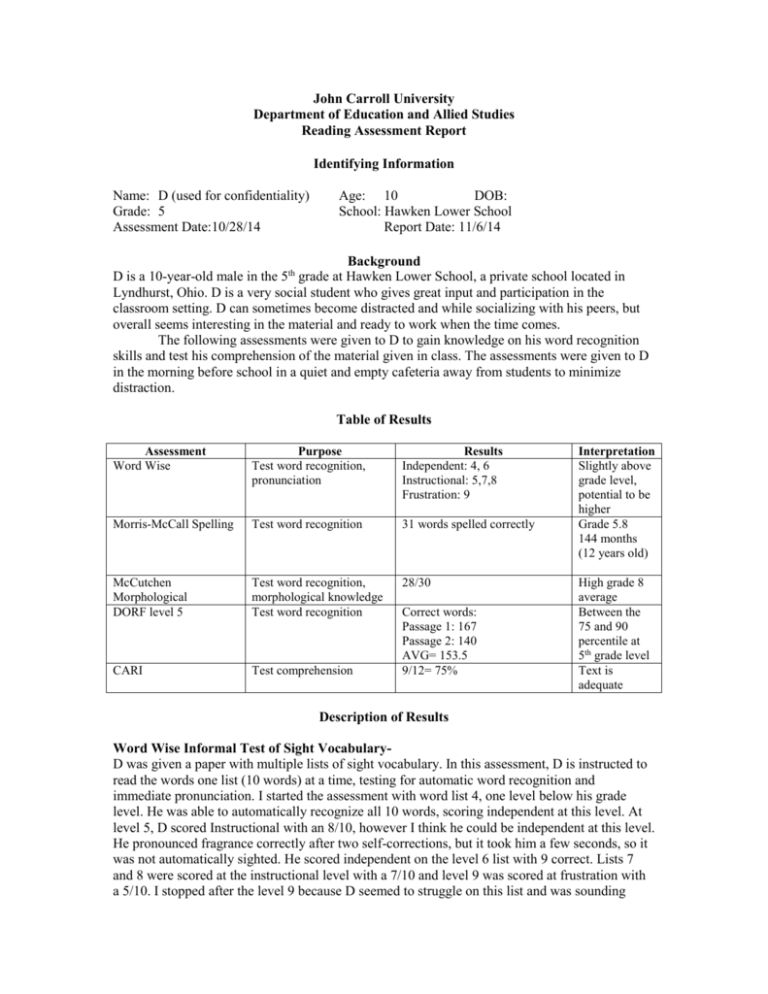
John Carroll University Department of Education and Allied Studies Reading Assessment Report Identifying Information Name: D (used for confidentiality) Grade: 5 Assessment Date:10/28/14 Age: 10 DOB: School: Hawken Lower School Report Date: 11/6/14 Background D is a 10-year-old male in the 5 grade at Hawken Lower School, a private school located in Lyndhurst, Ohio. D is a very social student who gives great input and participation in the classroom setting. D can sometimes become distracted and while socializing with his peers, but overall seems interesting in the material and ready to work when the time comes. The following assessments were given to D to gain knowledge on his word recognition skills and test his comprehension of the material given in class. The assessments were given to D in the morning before school in a quiet and empty cafeteria away from students to minimize distraction. th Table of Results Assessment Word Wise Purpose Test word recognition, pronunciation Results Independent: 4, 6 Instructional: 5,7,8 Frustration: 9 Morris-McCall Spelling Test word recognition 31 words spelled correctly McCutchen Morphological DORF level 5 Test word recognition, morphological knowledge Test word recognition 28/30 CARI Test comprehension Correct words: Passage 1: 167 Passage 2: 140 AVG= 153.5 9/12= 75% Interpretation Slightly above grade level, potential to be higher Grade 5.8 144 months (12 years old) High grade 8 average Between the 75 and 90 percentile at 5th grade level Text is adequate Description of Results Word Wise Informal Test of Sight VocabularyD was given a paper with multiple lists of sight vocabulary. In this assessment, D is instructed to read the words one list (10 words) at a time, testing for automatic word recognition and immediate pronunciation. I started the assessment with word list 4, one level below his grade level. He was able to automatically recognize all 10 words, scoring independent at this level. At level 5, D scored Instructional with an 8/10, however I think he could be independent at this level. He pronounced fragrance correctly after two self-corrections, but it took him a few seconds, so it was not automatically sighted. He scored independent on the level 6 list with 9 correct. Lists 7 and 8 were scored at the instructional level with a 7/10 and level 9 was scored at frustration with a 5/10. I stopped after the level 9 because D seemed to struggle on this list and was sounding discouraged. Many of the words within lists 6 and 7 were pronounced slowly and uncertainly, but may have been self corrected. The words in lists 8 and 9 that were marked incorrectly were mostly pronounced wrong or sounded out incorrectly. He was going very slow and seemed completely unfamiliar with the words in list 9. For example, chivalry was pronounced like “chive-al-ry”. Overall, D’s highest instructional level was the level 8 list, 3 levels above his grade. Morris-McCall Spelling List (Grades 2-9) The Morris-McCall Spelling list was given to test D’s ability to spell and decode words. It contains words in grades two through nine and is given until 5 consecutive words are spelled incorrectly. I read the word aloud and give a sentence containing that word as D spelled it on paper. D was able to spell 31 total words correctly out the given 50. There are places where it is easy to see his logic behind what was spelled and how he can improve in these areas. Many of the problems shown were in places where double letters are used; such as arrange spelled arange, written spelled writen, committee spelled comity, and many others. D spelled 5 consecutive words wrong starting at number 43, but since he was so close to the end I allowed him to finish the last 3 words. In the data shown, D is slightly above a 5th grade average and shows a high level or decoding skills. He is shown to be in the 5.8 grade level, which is where a 5th grader might be at the end of the year. The McCutchen Measure of Explicit Morphological Knowledge The McCutchen Measure was given to D to test his morphological awareness and ability to recognize multiple forms of a word. This assessment will determine the student’s ability to recognize separate morphemes in a word and apply the process of structural analysis to create a new word. The test is given on a sheet of paper where a word is bolded with a sentence following. The student must fill in the blank of the sentence, morphing the word into another form, without being given options. Out of 30, D was able to correctly morph 28 words. Out of the two he missed, one he was still able to make a different form of the word (allowed instead of allowance) and another he left blank. We are able to see that D has a great sense of morphological knowledge. This test also shows us how well he can spell when morphing a word, where D made 11 spelling errors overall. DIBELS Oral Reading Fluency The DIBELS Oral Reading Fluency Assessment (or DORF) is an assessment given to test a student ability to recognize words automatically and fluently. The test given to D was a Level 5 passage used to monitoring progress throughout the school year. The student is given a short passage (about 350 words) and is told to begin reading. After 1 minute, the student is told to stop. D was given two passages. After one minute, he was able to correctly read 167 words in the first passage and 140 in the second. In both passages he omitted or changed 1 to 2 words, causing his score to slightly drop. In his retell, D was able to recall between 6 to 8 ideas per passage. This puts D between the 75 and 90 percentile in rate for the 5th grade level and shows a high understanding of comprehension and summarization from his retell. Content Area Reading InventoryThe Content Area Reading Inventory (CARI) is an informal measure of a child’s ability to read and comprehend the materials actually used in the course. The test is created based on the informational text used in class and is designed to measure the student’s ability to use the given book and all of it’s properties. The assessment given to D was designed with three parts; using the book parts and textbook aids, testing vocabulary knowledge, and comprehension. The questions given can help to determine how confortable a child is with a text and whether or not it is an appropriate level of reading for them. It took D a few minutes to discover all the whereabouts of the book, but overall he did well. Scoring a 9/12, D seemed comfortable with using the index, glossaries, and tested well on vocabulary and comprehension. It seems that D know much more about the index than the table of contents. On questions 1 and 2, D went straight to the back of the book to look for page numbers or information on the given bolded words. However, the answer to number two was on the first page of the table of contents, which he never seemed to find. He also left a question blank where he was asked where metric unit charts were located, because he did not look in the front and back covers of the book. Overall, D seems very comfortable with the book and with practice this book will be a great informative and useful tool in his learning process. Interpretation of Results Word Recognition and Spelling D’s word recognition and spelling skills were determined by the use of the Word Wise, MorrisMcCall spelling inventory, the McCutchen Measure of Explicit Morphological Knowledge, and the DIBELS Oral Reading Fluency checks at the grade 5 level. On each of these assessments, D was able to score at or above the 5th grade average and seemed to display a sense of confidence and comfort. On the Word Wise Informational Test of Sight Vocabulary, D read words all the way up to the level 9 list, where he there reached a Frustrational Level. Although D scored at 8/10 on the list 5, he was able to reach independent at the level 6 and did not seem that he was at all in an instructional level until the level 7 list. This shows us that he has potential to be working at a level above grade 5. On the Morris-McCall Spelling list, D spelled 31 words correctly. The grade norms say that this score puts him just above the grade 5 average. According to the MorrisMcCall spelling list evaluation, D scored at the 5.8 grade level and 144-month range (or 12 years old). This tells us that he is currently at a place where students might be towards the end of the year. By analyzing the words D spelled wrong, we can see that he has a high level of decoding and phonological awareness. His mistakes are educated mistakes and it seems that he can use more work in double letters and vowel choice. Similar mistakes were shown in the McCutchen measure. D was able to properly identify 28 out of 30 morphed words. It is clear that D can identify and understand the meaning of words and has a strong sense of morphological knowledge. However, we can see that his spelling can still use some work in this assessment as well, were he spelled 18 words correctly out of the 29 he answered. The DORF was the last assessment used for word recognition. In this assessment, D read at a steady pace very fluently and firmly. His average between two passages was 153.5 words, putting him between the 75 and 90th percentile for his grade level according to Hasbrouck and Tindal’s Oral Reading Fluency Data. Overall, D seems to score at, if not slightly above, grade level for all of the assessments used to determine word recognition and spelling. He seems to be at the Syllable Juncture spelling stage, where he is able to spell multi-syllabic words but still has trouble with the doubling rule. However, according to McCutchen he has a high Derivational Consistency showing his ability to recognize semantic relationships between words. There is room for improvement, especially in spelling, but there are no signs of him falling behind or an inability to recognize and decode words. D is a solid student who will continue to progress and seems to be on track for the CCSS. Comprehension The CARI was used to determine D’s comprehension skills, as well as DORF retells. On the Content Area Reading Inventory, D scored 9 out of 12 possible questions. He showed an ability to browse the book and comfort using the material as a tool. These textbooks have only been used by the class once before, so he was not entirely familiar with the book’s setup. His CARI score shows us that D has an ability to read and comprehend material. For example, in the comprehension section D answered all but one of the answers fully. He was able to look at charts, pictures, and full chapters to answer tougher questions. The only reason he missed points is because he did not describe his answers in number 4. On the DORF retell, D was able to recall between 6-8 ideas for each story. His retells summarized major points and provided some detail. I think D has reached an advanced or adolescent reading stage. He is able to read fluently with an above average speed and involves expression and understanding in his reading. He is able to use a variety of parts of text to develop understanding, and can understand the connection between spelling, vocabulary, and word meaning changes. I think D will continue to make development in comprehension by forming an ability to elaborate on his understanding in words, such as using more description in his answers on the CARI. D should be on track, if not above grade level, for the end of the year CCSS. Conclusion D demonstrates solid word recognition and comprehension skills and is on track to exceed the end-of-year expectations. At this point, it seems that D’s comprehension is passing his spelling skills. He is able to read and comprehend material and has a great intelligence of semantics and text understanding. However, when spelling these words he can spell them well enough to determine the word but not spell all of them correctly. His McCutchen Measure shows this well, where he is able to morph the words and change the meaning, but not fully sound out the correct phonemes. His strong retelling abilities and automaticity will get him far in comprehension, but if D can keep up his spelling and decoding he will be an even stronger reader and be well above grade level. Recommendations D might benefit from some spelling activity and practice with words. There are many ways a spelling activity can double as a vocabulary activity and help increase D’s overall understanding. One recommendation would be to make a Word Wall in the classroom. This would be a general technique used on a constant basis and added to throughout the year. It will be visible so students can always refer to it and build on it’s meaning throughout the year. The type of word wall D would benefit from is one with categories, such as inflected endings, double letter words, and multi-syllabic words. By using vocabulary words that display these properties, D can see them in context and become more familiar with patterns and structural forms. This intervention could last for multiple weeks, such as one unit or 3-4 weeks, and be referred to twothree times a week. Instruction using the word wall could be beneficial if working in pairs or using words across multiple domains, such as writing with them, spelling them, or using them in word sorts and games. The key to this intervention is to use words with certain patterns on a constant basis to make the student more familiar and comfortable without a crash course or intense intervention. Attached is a list of games and activities to do with the word wall. A second recommendation for D (which can branch off of the first one) would be to implement a weekly spelling test. These could be very informal and a quick way to start or end class. Using the words in your word wall, allow the students to study them and work with the words as mentioned above. After working with them for some time, administer spelling tests. This will help with vocabulary and spelling skills and help for recognition of harder words later in the lesson. Spelling tests can happen with fewer words more frequently, or with all words, less frequently. This would be an individual intervention and can be individualized for students so that they learn to spell words that would benefit their writing skills. Another recommendation for D would be practice using informational text. This could include working with new vocabulary and elaborating on interpreted text. One way this could be practiced in the classroom is by Partner Reading and Partner Shares. Students can work together to read and elaborate on a given text and answer questions as a group. Also, students can do individual work on the text and share their findings with a peer, decoding the text and it’s meaning together. This would be a very general technique used as a preventative idea of falling behind with text in the classroom. This could be done once a week or once a chapter. Before a lesson, students can search the text to find key ideas or vocabulary and familiarize themselves with the content, helping for later comprehension. This can be done as a small group activity with two or three students in a group. Lastly, another recommendation for informational text would be to use brainstorming tools or graphic organizers. One example of this can be a K-W-L Chart. Using a K-W-L chart will allow the teacher to assess D’s prior knowledge, and allow D to ask questions and elaborate on text and vocabulary he may be unfamiliar with. This can be a general technique for organizing information and can be referred to two or three times a week while working with an informational text. Using the chart can also allow the teacher to pick a text appropriate for the student’s comprehension level and stay updated with how they are working with the text and their interest in the material. Word Wall Activities: Clap, Chant, Write 1. Teacher introduces 5 Word Wall words per week by having students: * See the words * Say the words * Chant the words (snap, clap, stomp, cheer) * Write the words and check them together with the teacher * Trace around the words and check together with the teacher 2. Have the students number a sheet of paper 1-5. 3. Place one of the 5 new word cards on the word wall. Say the word, use the word in a sentence, have students write the word on their paper. 4. Continue with 4 additional words. 5. When all five words have been written, point to the words and have the students clap and chant the spelling of the words. 6. Students use a red pen, marker or crayon to trace around the word. 7. For the remainder of the week, teacher practices the new Word Wall words and focuses on using them in other areas of class. On-the-back - Cross Checking 1. Students number front and back of paper from 1-5. 2. Teacher calls out several words that begin with the same letter for students to write on the front of their paper, (e.g. went, want, was, what where- use 5 words from word wall) 3. Teacher tells students that they will have to decide which word from the front makes sense in each sentence. 4. Teacher reads a sentence but say BLANK where the word should go. 5. Students decide which word makes sense in the sentence and writes that word in the correct spot on the back. Examples: I __ to the beach. It ____ very hot today. _____ do you want for lunch? _____ should we go first? I _____ to go home. Sentences could use the same word wall words in multiple forms to practice morphological knowledge Check with neighbor for spelling



